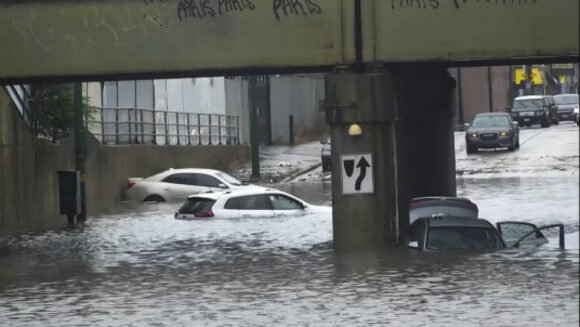Heavy rains that flooded Chicago neighborhoods, rendered freeways impassable and wreaked havoc on NASCAR street races downtown Sunday are serving as stark reminders of urban centers’ vulnerability during extreme weather events.
After a historic deluge in April in Fort Lauderdale, Florida, residents had to wade through knee- and chest-high water, and navigate the streets on canoes and kayaks. In Texas, heavy rains across the drought-stricken Dallas-Fort Worth area last August led to hundreds of high-water calls.
With projections calling for more frequent and powerful storms as climate change continues, cities like Chicago will have to look for new ways to mitigate flooding, said Max Berkelhammer, an associate professor in earth and environmental sciences at the University of Illinois-Chicago.
“That’s really where the challenges are,” Berkelhammer said. “You can build a lot of infrastructure but in a city like Chicago, in a storm like yesterday, you have to find a place for (the run-off) to go.”
Sunday’s flooding was caused by a storm system that stalled over the northeastern corner of Illinois. Instead of moving east over Lake Michigan, the storm pinwheeled around Chicago, dumping as much as 9 inches (23 centimeters) of rain in some areas over the course of Sunday afternoon.
Ed Staudacher, assistant director of maintenance and operations for the Metropolitan Water Reclamation District of Greater Chicago, said so much run-off flowed into the city’s sewer system that it filled one of the city’s three reservoirs with almost 5 billion gallons of water.
The Chicago River rose six feet (2 meters) during the storm, forcing workers to close a series of locks and reverse the river’s flow from west to east into Lake Michigan to prevent more flooding, he said. The mayor issued a statement asking people to refrain from taking showers and washing dishes to prevent even more run-off from filling the sewers.
“I’ve lived through quite a few storms,” Staudacher said. “(But) it’s still nerve-wracking because you’re watching gauges climb. It’s a very stressful day but we have the systems in place to handle this.”
Still, three feet (1 meter) of water poured into hundreds if not thousands of basements on the city’s west side, said Rich Guidice, Mayor Brandon Johnson’s chief of staff.
Portions of some interstates crossing the city were closed due to flooding. Low- lying streets, especially under overpasses, became ponds too deep to cross with a car. NASCAR cancelled a downtown Xfinity Series race that was slated for Sunday morning – and delayed the start of a Cup Series race set to follow that afternoon.
Berkelhammer, the environmental scientist from the University of Illinois- Chicago, said modeling suggests storms will grow more intense as the climate warms even more in the coming years. That means trouble for many of the nation’s biggest cities.
Metropolitan areas naturally produce more heat, which rises into the atmosphere and can lead to heavier rainfall. Many impervious surfaces in cities – concrete, asphalt, roofs, buildings – prevent rain from seeping into the earth. That all translates to more severe flooding, he said.
Staudacher noted that Chicago is expanding the reservoir that caught Sunday’s rain, with completion set for 2029.
“We’re not done by any stretch here,” he said.
But climate change experts say strategies that municipal planners have used for decades no longer apply, said Gabriele Villarini, a professor at Princeton University’s High Meadows Environmental Institute.
“One thing that we’re still doing is designing (infrastructure) with statistics from the past in mind,” Villarini said. “The challenge now is how to design infrastructure with climate change in mind.”
Villarini said some of the solutions to mitigate the impact of flooding that some cities are considering include building larger green areas to allow water to seep into the ground as well as water-retention ponds and other projects to store water.
“A lot of rainfall will cause flooding and it’s hard to design a system where you will get no flooding. That would be cost-prohibitive,” Villarini said. “There is a tradeoff between how much you want to spend on your infrastructure and what would be the benefit of that infrastructure.”
The city of Milwaukee, for example, has built a number of so-called green alleyways, which are alleys with sections of porous material that allow water to seep through into the earth.
“You want that sponge and you want that water absorbed,” Berkelhammer said. “Decisions that can mitigate (flooding) are really needed … we’re fighting an uphill battle, particularly in Chicago.”
Top photo: In this image taken from video provided by ABC7 Chicago, several vehicles are stranded in the flooded viaduct at Fifth and Cicero avenues, in Chicago, Sunday, July 2, 2023. (ABC7 Chicago via AP)
Was this article valuable?
Here are more articles you may enjoy.


 Surging Oil Tanker Insurance Points to Growing Black Sea Chaos
Surging Oil Tanker Insurance Points to Growing Black Sea Chaos  Palantir Poaching Suit Called ‘Scare’ Tactic by Ex-Employees
Palantir Poaching Suit Called ‘Scare’ Tactic by Ex-Employees  What The Return of California’s ‘Death Discount’ Means for Litigation
What The Return of California’s ‘Death Discount’ Means for Litigation  Cyber Breach Affected 750,000 Canadian Investors, Regulator Says
Cyber Breach Affected 750,000 Canadian Investors, Regulator Says 